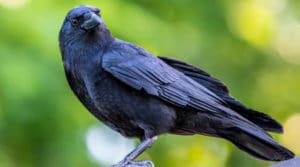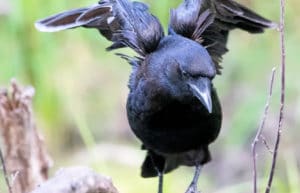These big-brained birds are smart!
Fascinating to many, considered a poopy pest by others, the American Crow is a valuable member of the Huron River watershed ecosystem.

Crow biology and behavior
The American Crow (Corvus brachyrhynchos) ranges over most of the United States and Canada. They can be distinguished from their larger cousins, ravens, by their “caw” call and the shape of their tail in flight; it makes a spade shape, while raven tails fan out. Also, it is rare to see a raven in the Huron watershed as it is not within their normal migratory range (though there are many in the Westeros watersheds).
Termed by biologists as “generalists,” crows can take advantage of nearly any kind of landscape, from open fields to the densest cities. They gather in flocks (“murders”) of up to 20,000, as they do in Ann Arbor every winter (last winter they roosted at the Forest Hill Cemetery on Geddes
and S. Observatory). This gathering of multiple families into large murders occurs over winter, as crows seek warmth and protection from predators.
Most of the year crows live in families, with parents (mated for life) and other relatives helping raise young and build nests. Families hunt and forage together, with different members in different roles. Some do the foraging while others serve as lookouts.
Crow Intelligence

Crows are the “brainiacs” of the bird world. They can mimic other animals, count, problem-solve, and use tools. Even ants can serve as tools for crows. Called “anting behavior,” a crow will stand on an ant hill and let the ants crawl all over it. The ants release formic acid, which makes them palatable and cleans the crow of parasites. In addition, crows have been observed hunting cooperatively, using complex behaviors such as herding rabbits into a road and then cleaning up the resulting roadkill.
Crows can even recognize individual people, as observed by researchers studying crow intelligence. Researchers wore Neanderthal masks while handling trapped and banded crows. When the same researchers, unmasked, walked around the areas where they did the banding, there was no response. But when they walked around the area wearing the masks, the crows, joined by other crows who had not been captured, dive bombed and cawed at them. As time went on and the banded crows had passed away, the descendent crows continued harassing only the individual researchers they recognized—they learned to “hate” the “bad” humans from their past “kidnappings.” This is an indication that crows learn culture and do not merely act on instinct. Researchers have also found that they have big brains for their size; including larger forebrains than other birds, similar to primates. This may explain why these birds display analytical thought, sensory processing, and flexible behavior.
Crows: pests or ecosystem service providers?
Crows have a bad reputation for eating up farm crops, leading to (usually ineffective) scarecrows dotting fields. In fact, researchers have found that the ecological benefits crows provide to agriculture outweigh the negative impacts. In addition to scavenging garbage and devouring small rodents, crows also feast on common agricultural pests. One crow family of 5-8 birds can eat 40,000 insects during one season. So, it may be just-as-well that scarecrows fail to scare crows away.
Many cities have worked hard to keep crows from forming their wintertime murders, including setting off fireworks to keep crows from massing in downtown areas. However, crows provide benefits here too in the form of roadkill clean-up and garden pest control.
Crows have also served as early warning beacons for West Nile Virus outbreaks—they are very vulnerable to it. The U.S. has lost an average of 45% of the crow population since the first West Nile outbreak. Public health officials can get a jump on protecting human populations by observing an outbreak in the local crow population. In the Ann Arbor area, crows took a hit from West Nile in the 2000’s but seem to be slowly recovering to historic numbers. (Crows cannot spread West Nile Virus to humans.)
So, let’s retire those Neanderthal masks and commit to appreciating the American crow!
Interested in learning about crows?
Start here:
Crows are too clever to fall for scarecrows’ bluster, The Tribune, October 12, 2016
Counting crows in Ann Arbor, The Washtenaw Voice, February 9, 2021
Meet the misunderstood American crow, Times Herald, September 29, 2019
Meet the Bird Brainiacs: American Crow, Audubon, March-April 2016
Upcoming talk on crows:
Elderwise, on January 19, 2022. Details coming soon!
This blog post was originally published September 1st in the Huron River Report, Fall 2021.



